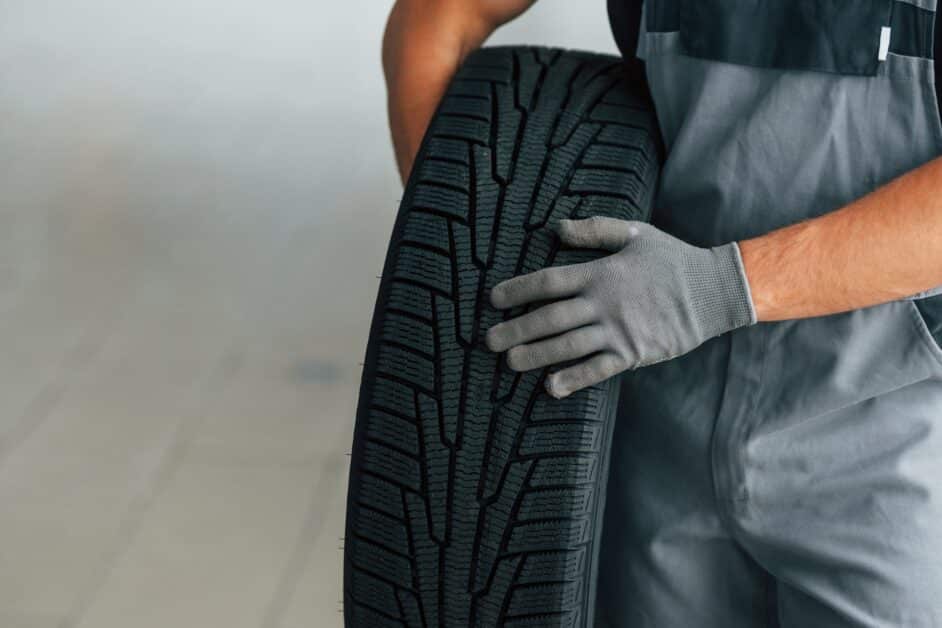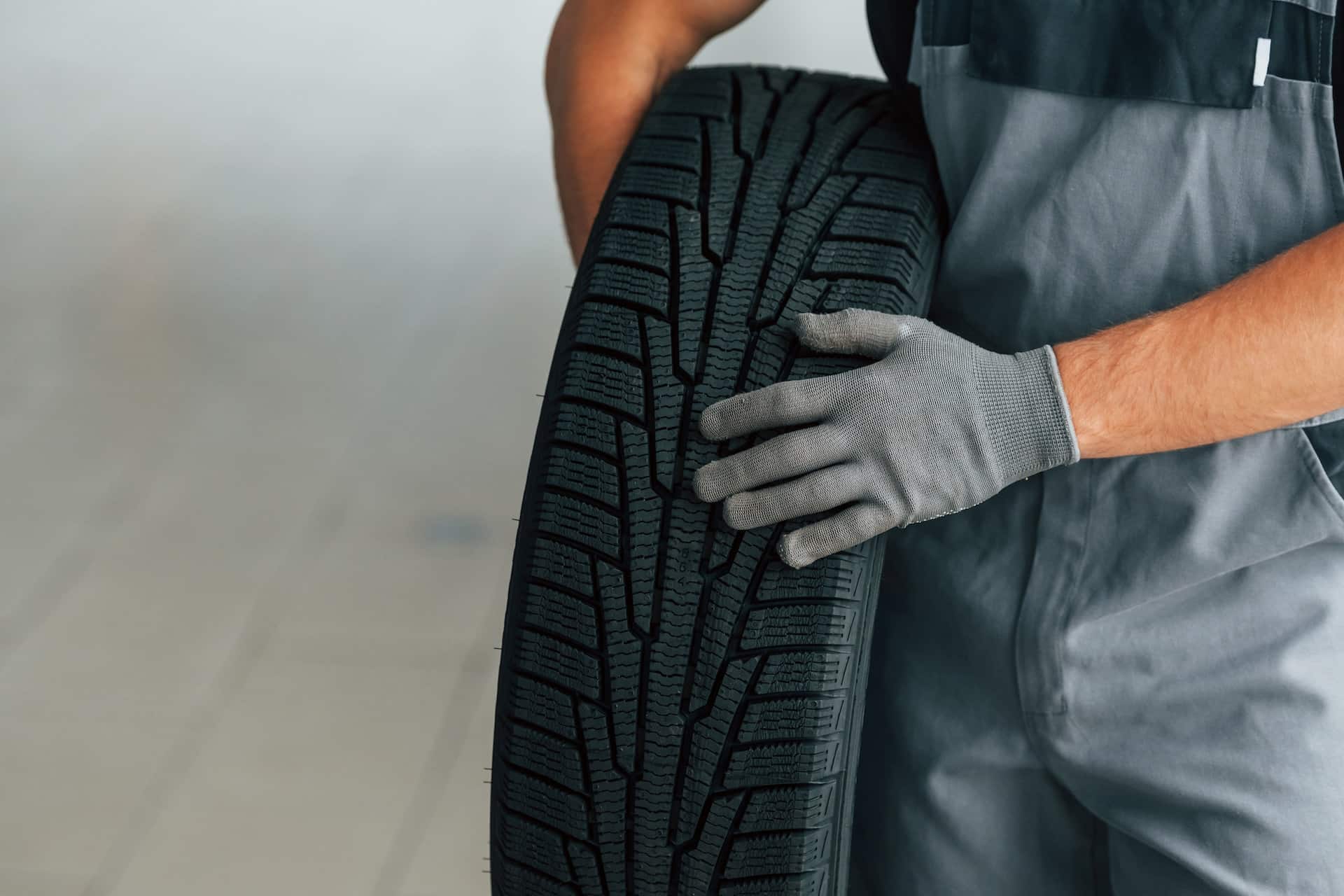Tire safety is crucial for vehicle maintenance and shouldn’t be ignored. It’s important to know when to replace your tires to ensure the safety of you and your passengers. Spotting signs of tire wear helps you maintain performance and avoid accidents.
Look for these signs to see if you need new tires: worn tread bars, cracks in the rubber, uneven tread wear, and bulges in the sidewall. Noticing these issues is key to staying safe while driving.
So, how do you know when it’s time for new tires? Let’s explore the key tire replacement indicators in detail:
- Regularly monitor your tires for signs of wear and damage.
- Check for worn tread bars, cracked rubber, uneven tread wear, tire pressure issues, and sidewall bulges.
- Use the penny test to measure tire tread depth.
- Uneven tire tread may indicate alignment issues or lack of rotation.
- Monitor tire pressure regularly and address any continuous air loss promptly.
Tread Wear Bars as Tire Replacement Indicators
In this section, we will discuss tread wear bars and how they serve as indicators for tire replacement. Tread wear bars are raised bits of rubber that run between the tread blocks on your tires. They are designed to help you determine when it’s time to replace your tires.
As the tread on your tires wears down over time, these bars become flush with the tread. When you notice that the tread wear bars are level with the tread blocks, it’s a clear sign that your tires are worn out and need to be replaced. This is because the tread depth has reached a point where it can no longer provide adequate traction and grip on the road.
To make it easier for you to gauge the tread depth, you can also perform the penny test. Simply take a penny and insert it into the tread with Lincoln’s head pointing down. If you can see the top of Lincoln’s head, it means that the tread is too shallow, and it’s time to get new tires. On the other hand, if the tread covers Lincoln’s head, it indicates that the tread depth is still sufficient.
Tire Replacement Indicators

Knowing when to replace your tires is crucial for your safety on the road. Tread wear bars and the penny test are simple yet effective ways to determine if your tires are worn out. By keeping an eye on these indicators, you can ensure that you always have tires with optimal tread depth, providing you with the traction and control you need for a smooth and safe ride.
Cracked Rubber and Tire Lifespan
When managing tire maintenance, watch for cracked rubber to ensure road safety. Rubber cracks over time due to sunlight, heat, and chemical exposure, weakening the tire and increasing failure risks. Regular checks and maintenance are key to catching issues early.
To keep tires flexible and extend their life, follow these tips: avoid long-term parking in direct sunlight to prevent UV damage, and clean your tires with mild soap and water, avoiding harsh chemicals.
Tires typically last up to 10 years, depending on driving habits and maintenance. However, it’s wise to get them professionally inspected regularly, especially after five years. Replace any tires that are 10 years old to maintain safety, even if they look fine. On average, tires can safely cover around 60,000 to 75,000 miles before needing replacement.
| Tire Maintenance Tips | Recommendation |
|---|---|
| Regular Inspection | Inspect tires for cracks or signs of damage at least once a month |
| Cleaning | Use mild soap and water to clean tires, avoiding harsh chemicals |
| Parking | Avoid parking your vehicle under direct sunlight for extended periods |
| Professional Inspection | Have a comprehensive inspection by a professional after five years |
By following these tire maintenance tips and regularly inspecting for cracked rubber, you can help ensure your tires remain in good condition and maximize their lifespan for a safer driving experience.
Tire Maintenance Tips for Preventing Uneven Tire Tread and Tire Wear
Proper tire maintenance is crucial for ensuring optimal safety and performance on the road. One important aspect to consider is preventing uneven tire tread and tire wear, which can compromise the lifespan of your tires and pose a safety hazard. By following these tire maintenance tips, you can help prolong the life of your tires and maintain optimal traction.
Regular Tire Rotation
Uneven tire wear can occur due to various factors, such as alignment issues, incorrect tire pressure, lack of rotation, or worn steering and suspension components. To minimize uneven wear, it is recommended to rotate your tires regularly. By rotating your tires at specific intervals (every 5,000 to 8,000 miles or as recommended by the tire manufacturer), you can distribute the wear more evenly across all four tires. This will help extend the lifespan of your tires and improve overall handling and stability.
Proper Tire Inflation
Maintaining the correct tire pressure is essential for preventing uneven tire tread and wear. Underinflated tires can cause the outer edges to wear faster, while overinflated tires may cause the center of the tread to wear more quickly. To ensure proper tire inflation, check your tire pressure regularly using a tire pressure gauge and adjust it to the manufacturer’s recommended PSI (pounds per square inch). Properly inflated tires not only promote even tread wear but also enhance fuel efficiency and handling.
Alignment and Suspension Inspections
Alignment issues and worn steering or suspension components can also contribute to uneven tire tread wear. If you notice uneven wear patterns or experience vibrations while driving, it is essential to have your vehicle’s alignment and suspension checked by a professional. Correcting any alignment or suspension issues will help maintain even tread wear and improve the overall performance and safety of your tires.
By following these tire maintenance tips, you can reduce the risk of uneven tire tread and tire wear, prolong the lifespan of your tires, and ensure a safer and smoother driving experience. Remember to regularly inspect your tires for any signs of wear or damage, including sidewall bulges, cracks, or any other abnormalities. Addressing these issues promptly will help maintain the integrity of your tires and keep you and your passengers safe on the road.
Tire Pressure Issues and Monitoring
Tire pressure is a critical aspect of tire maintenance that directly impacts both the performance and safety of your vehicle. Monitoring tire pressure regularly is essential to ensure optimal performance and prevent potential issues on the road.
Properly inflated tires provide better traction, handling, and fuel efficiency. On the other hand, underinflated or overinflated tires can lead to reduced grip, increased braking distance, and uneven and accelerated tread wear.
To prevent these issues, it is recommended to check your tire pressure at least once a month. You can use a tire pressure gauge to measure the pressure accurately. If you notice a continuous decrease in tire pressure or receive frequent alerts from your Tire Pressure Monitoring System (TPMS), it may indicate a need for tire repair or replacement.
Remember that tires naturally lose about 1 PSI (pound per square inch) per month, so regular monitoring and maintenance are crucial to keep them properly inflated. By maintaining the correct tire pressure, you not only ensure your safety but also extend the lifespan of your tires.
Tire Maintenance Tips for Proper Tire Pressure:
- Refer to your vehicle’s owner’s manual for the recommended tire pressure.
- Use a reliable tire pressure gauge to measure the pressure accurately.
- Check tire pressure when the tires are cold, as driving can increase the pressure and give inaccurate readings.
- Add or release air as needed to maintain the recommended tire pressure.
- Inspect your tires regularly for any signs of damage or punctures that could affect pressure.
Tire Replacement Indicators:
Monitoring tire pressure goes hand in hand with monitoring other tire replacement indicators. If you notice any of the following signs, it may be time to consider replacing your tires:
- Worn tread bars: When the tread wears down to the same level as the tread bars, it’s time for new tires.
- Cracked rubber: Rubber can crack over time, leading to reduced tire flexibility and potential failure.
- Uneven tread wear: This can be caused by alignment issues, tire pressure problems, lack of rotation, or worn steering and suspension components.
- Sidewall bulges: Bulges in the sidewall can indicate potential tire rupture and should be inspected immediately.
By regularly monitoring and maintaining proper tire pressure, along with being aware of other tire replacement indicators, you can ensure the safety and longevity of your tires, as well as enjoy a smoother and more comfortable ride.
Sidewall Bulges and Tire Safety
Sidewall bulges are a critical sign of tire wear and should never be ignored. These bulges are often caused by hitting obstacles such as potholes or curbs. When the sidewall is damaged, it weakens the tire’s structural integrity, increasing the risk of a sudden blowout or rupture. This can be extremely dangerous, especially at high speeds or on busy roads. Therefore, it is crucial to inspect your tires regularly and address any sidewall bulges promptly.
Tire Maintenance Tips
To prevent sidewall bulges and ensure tire safety, here are a few maintenance tips to keep in mind:
- Regularly inspect your tires for any signs of bulging or other damage.
- Avoid hitting curbs, potholes, and other road hazards whenever possible.
- Maintain proper tire inflation to reduce the risk of stress on the sidewalls.
- Rotate your tires regularly to promote even wear and prolong their lifespan.
- Follow the manufacturer’s recommended tire maintenance schedule.
Signs of Worn-Out Tires
In addition to sidewall bulges, there are other signs that indicate your tires may need to be replaced:
- Worn tread: If the tread depth is below the recommended level, it’s time for new tires.
- Cracked rubber: Cracks in the tire’s rubber can compromise its strength and safety.
- Uneven tread wear: Uneven wear patterns across the tire surface indicate alignment or suspension issues.
- Tire pressure issues: Constantly low tire pressure or frequent TPMS alerts can be a sign of tire damage.
By staying vigilant and addressing these signs promptly, you can ensure the safety of yourself and others on the road.
| Signs of Worn-Out Tires | Sidewall Bulges | Tire Pressure Issues |
|---|---|---|
| Worn tread | Caused by hitting obstacles | Constantly low tire pressure |
| Cracked rubber | Weakens tire’s structural integrity | Frequent TPMS alerts |
| Uneven tread wear | Inspect regularly | Tire damage |
Tire Age and Replacement Guidelines
When it comes to tire replacement, age and condition play significant roles. Regular inspections by a professional are essential, with a comprehensive inspection recommended after five years. It’s important to remember that tires have a recommended lifespan of up to 10 years, taking into account factors such as tread wear and damage.
After 10 years, even if they appear new, it’s time to replace your tires. Aging tires can become more susceptible to failure, impacting safety on the road. To ensure optimal performance and adherence to safety standards, it’s crucial to replace tires that have reached their recommended lifespan.
Table: Tire Replacement Guidelines
| Tire Age (Years) | Tire Condition | Recommended Action |
|---|---|---|
| 0-5 | Good tread depth, no visible damage | No immediate replacement necessary. Regular inspections still required. |
| 5-10 | Visible tread wear, minor damage | Comprehensive inspection recommended. Replace if tread wear or damage is significant. |
| 10+ | Aging tires, signs of wear, or damage | Replace immediately, regardless of appearance. |
By following these tire age and replacement guidelines, you can ensure the safety and performance of your vehicle. Regular inspections, along with proactive tire maintenance, will help you stay ahead of potential issues and maintain optimal road safety.
Conclusion
In conclusion, proper tire maintenance is crucial for optimal safety on the road. By following these tire maintenance tips and recognizing the signs of worn-out tires, you can ensure a smooth and secure driving experience.
Regularly monitor your tire tread wear, checking for worn tread bars and using the penny test to determine if it’s time for new tires. Inspect your tires for cracked rubber, as this can lead to tire failure, and maintain tire flexibility to prolong their lifespan.
Additionally, address any issues with uneven tire tread through regular rotation and consider alignment, tire pressure, and suspension components. Always monitor your tire pressure to keep them properly inflated, ensuring optimal performance and safety on the road.
Lastly, be vigilant for sidewall bulges and address them immediately as they can indicate potential tire rupture. Remember that tire age and condition are important factors in determining when to replace your tires, with a recommended lifespan of up to 10 years.
FAQ
What are some signs that indicate the need for new tires?
Some signs include worn tread bars, cracked rubber, uneven tread wear, tire pressure issues, and sidewall bulges.
How do I know when the tread bars are worn and need new tires?
Tread wear bars are raised bits of rubber that run between the tread blocks. When these bars become flush with the tread, it’s time for new tires.
How can I check the tire tread depth?
You can use the penny test by placing a penny in the tread with Lincoln’s head pointing down. If the top of his head is visible, it’s time to replace the tire.
Why do tires crack and what does it indicate?
Rubber can crack over time due to sunlight, heat, and chemicals, which can lead to tire failure. Cracked rubber indicates the need for tire replacement.
What causes uneven tire tread wear?
Uneven tire tread wear can be caused by alignment issues, tire pressure, lack of rotation, or worn steering and suspension components.
How often should I rotate my tires to reduce uneven wear?
Regular rotation is recommended to prolong tire life and reduce uneven wear. It is recommended to rotate the tires regularly to ensure even tread wear.
Why is it important to check tire pressure?
All tires deflate slowly over time, losing about 1 PSI per month. Checking tire pressure monthly is essential to keep them properly inflated for optimal performance and safety.
What do sidewall bulges indicate and what should I do if I notice them?
Sidewall bulges can indicate a potential tire rupture and should be inspected immediately. Bulging tires need to be replaced to ensure safety on the road.
How long should tires typically last and when should they be replaced?
Tires usually last up to 10 years, considering factors like tread wear and damage. However, they should be inspected by a professional regularly, with a comprehensive inspection after five years.
Source Links
- https://living.geico.com/driving/auto/auto-care/5-signs-you-need-new-tires/
- https://www.bridgestoneamericas.com/en/company/safety/choosing-tires/replacement-guidance
- https://www.lesschwab.com/article/tires/how-do-i-know-when-i-need-new-tires.html


